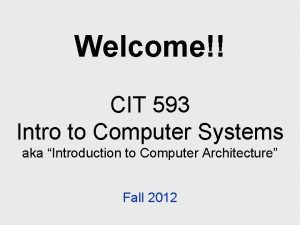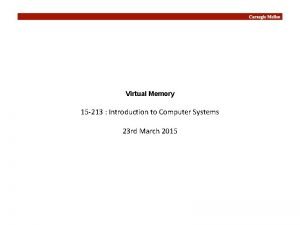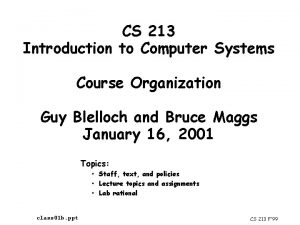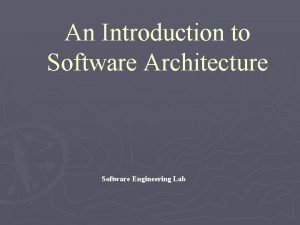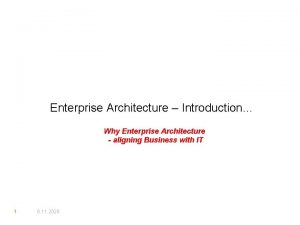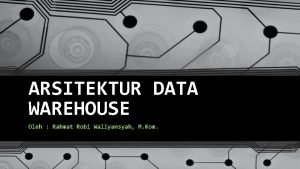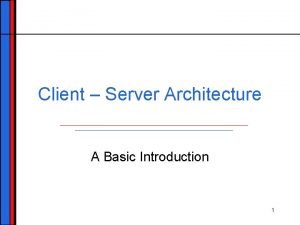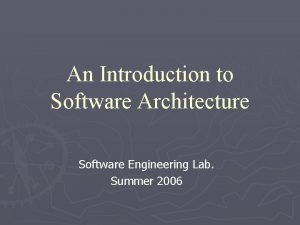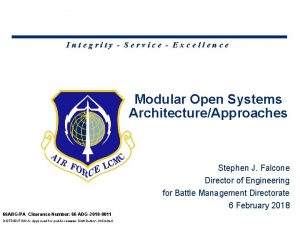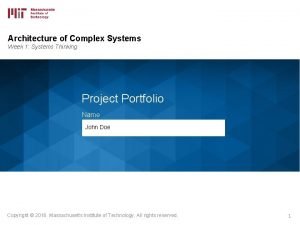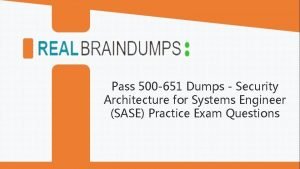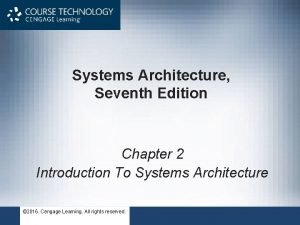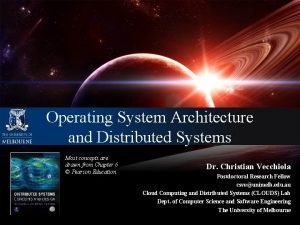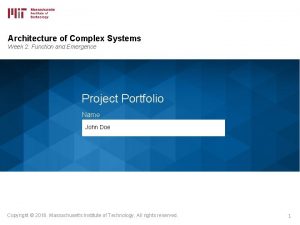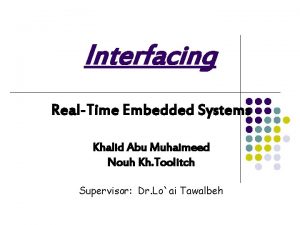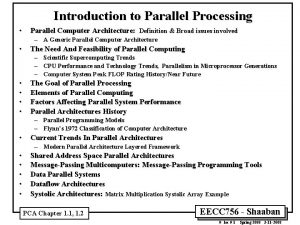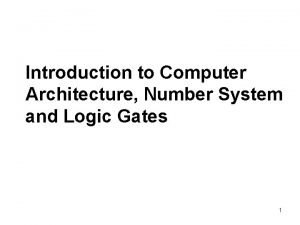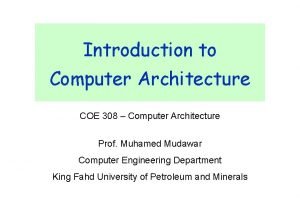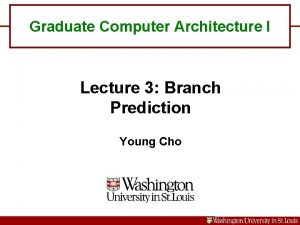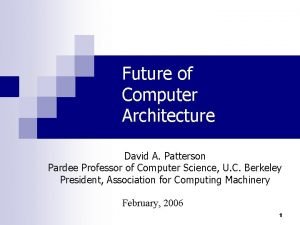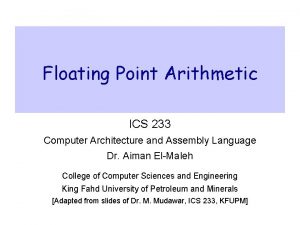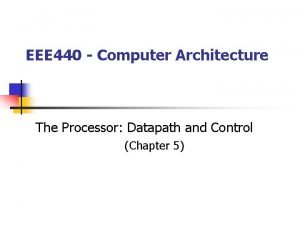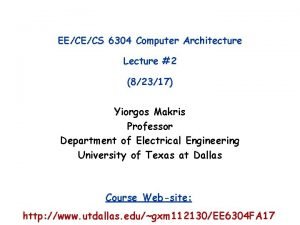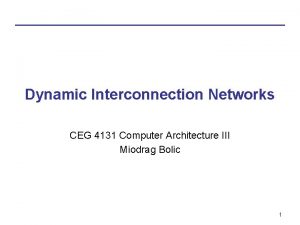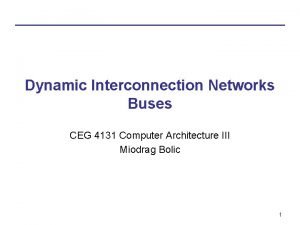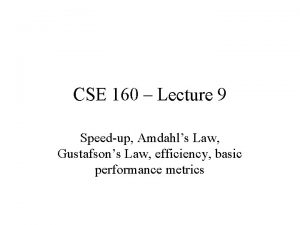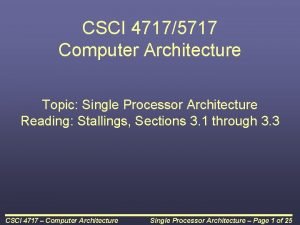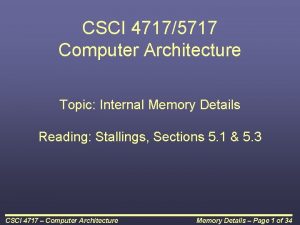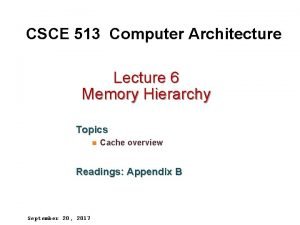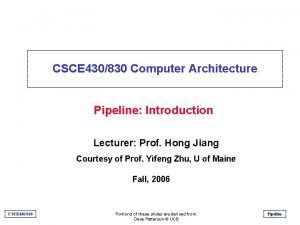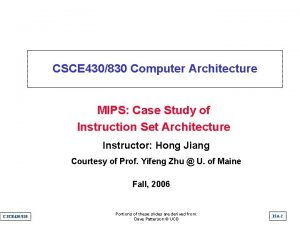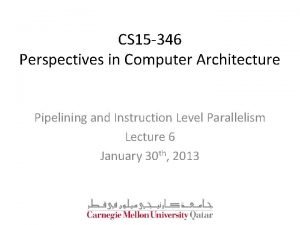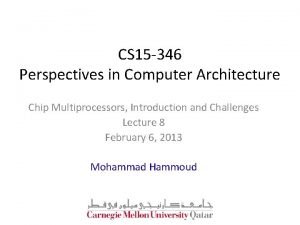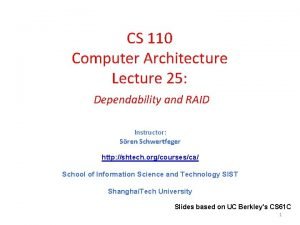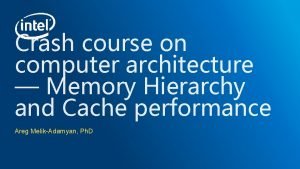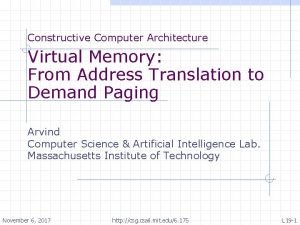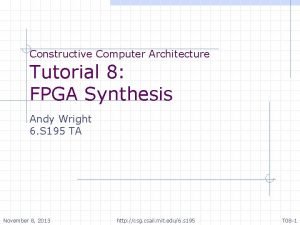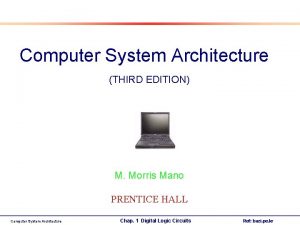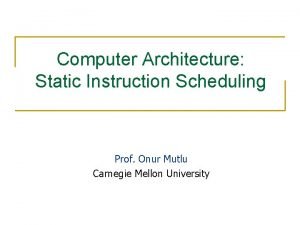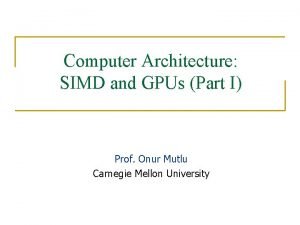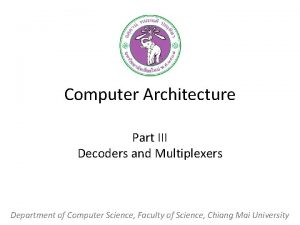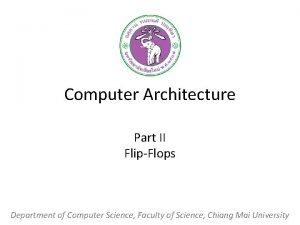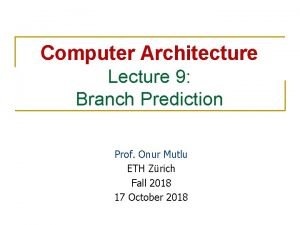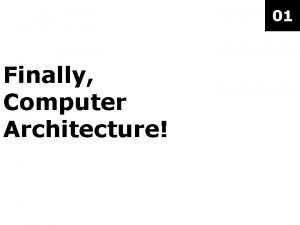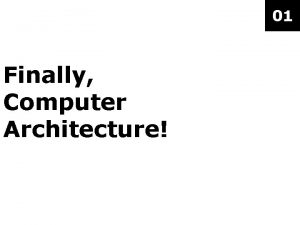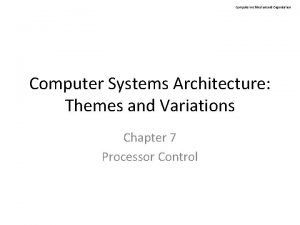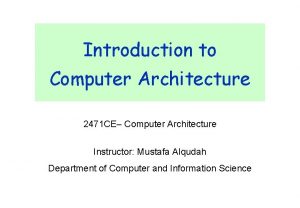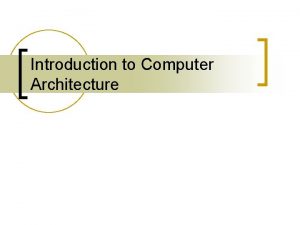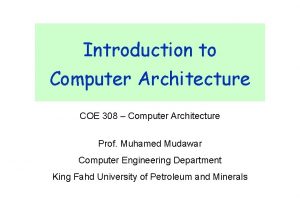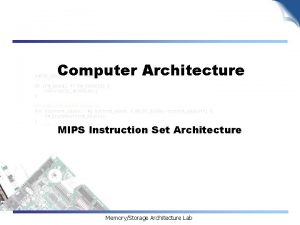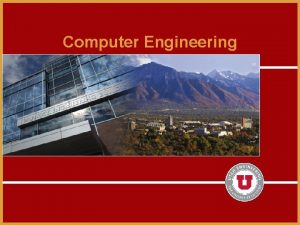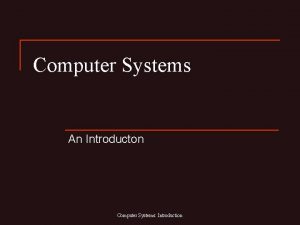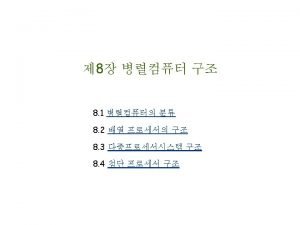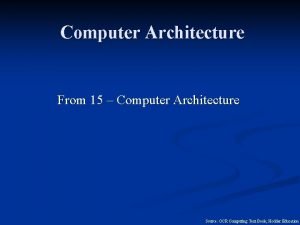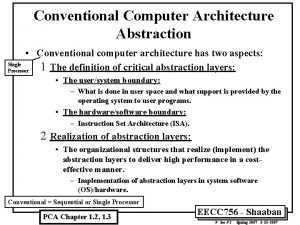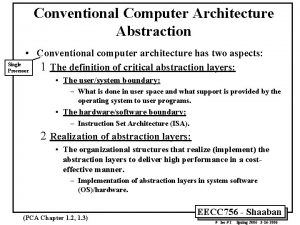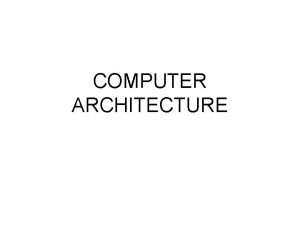Introduction to computer Systems Architecture of computer Systems


















































































- Slides: 82

Introduction to computer Systems. Architecture of computer Systems. Suleyman Demirel University 2017

What Computer word mean? • The term ‘computer’ is derived from the Latin term ‘computare’, this means to calculate.

History of Computer • • Human calculations Mechanical tools Analog computer Digital computer

Human calculations • Count by putting marks/signs. • Count by fingers. • Count by writing symbols on sand, tree, stone or paper. • Count in mind using knowledge of symbols.

Human calculations

Mechanical tools • Abacus • Punched cards • Mechanical Calculator

Mechanical tools

1 st mechanical calculator invented by Blaise Pascal in the early 17 th century

Mechanical calculator

Analog Computer • An analog computer is a form of computer that uses the continuously-changed aspects of physical phenomena such as electrical, mechanical, or hydraulic quantities to model the problem being solved. • Hydraulics (From Greek: Υδραυλική) is a technology and applied science using engineering, chemistry, and other sciences involving the mechanical properties and use of liquids or fluids. At a very basic level, hydraulics is the liquid version of pneumatics.

Analog Computer

Digital Computer • Digital Computers were developed between 1940 and 1945 in UK and USA. Digital Computers work by electricity and represent all data in binary system by 1 and 0.

Digital Computer

What is binary system? • In mathematics and digital electronics, a binary number is a number expressed in the binary numeral system orbase-2 numeral system which represents numeric values using two different symbols: typically 0 (zero) and 1 (one). The base 2 system is a positional notation with a radix of 2. Because of its straightforward implementation in digital electronic circuitry using logic gates, the binary system is used internally by almost all modern computers and computer-based devices. Each digit is referred to as a bit.

History of binary system • Binary calculation has been found in: – Egypt, approximately 1200 BC – China, 9 th BC – India, 2 nd BC and in other cultures… • France, Gottfried Leibniz and the I Ching, 1703 • British mathematician George Boole , 1854

History of binary system

ENIAC • One of the first computers was ENIAC (Electronic Numerical Integrator and Computer). ENIAC was announced in 1946, it was very big computer which took place of big room

ENIAC

What is a Computer? • Computer is electronic device which makes arithmetic and logical operations; it takes raw data as input from the user and processes these data under the control of programs and gives result (output). Input Process Output

Input/Process/Output Example: Input 25+25 Process 25+25=50 Output 50

Computer classification by size: Computer Microcomputers Minicomputers Mainframe Supercomputers

Microcomputers • Microcomputers are the most common kind of computers in use as of 2014. The term “microcomputer” was introduced with the advent of systems based on single chip microprocessors. – Labtop – Notebook – Tablets – Smart phones, smart books – Programmable calculator

Microcomputers

Minicomputers • Minicomputers (colloquially, minis) are a class of multi-user computers that lie in the middle range of the computing spectrum, in between the smallest mainframe computers and the largest single-user systems (microcomputers or personal computers)

Minicomputers

Mainframe • The term mainframe computer was created to distinguish the traditional, large, institutional computer intended to service multiple users from the smaller, single user machines.

Mainframe

Supercomputer • A Supercomputer is focused on performing tasks involving intense numerical calculations such as weather forecasting, fluid dynamics, nuclear simulations, theoretical astrophysics, and complex scientific computations.

Supercomputer

What computer consist of? Computer Hardware Software

What is hardware? • All physical components of Computer

What is inside computer case/system unit?

CD ROM • A CD-ROM isa pre-pressed optical compact disc which contains data. The name is an acronym which stands for "Compact Disc Read-Only Memory". Computers can read CD-ROMs, but cannot write to CD-ROMs which are not writable or erasable.

CD ROM

Hard Disc Driver • A hard disk drive (HDD), hard disk, hard drive or fixed disk is a data storage device that uses magnetic storage to store and retrieve digital information using one or more rigid rapidly rotating disks (platters) coated with magnetic material. • Another name of HDD is Winchester.

Another name of HDD is Winchester • 1894, 30 -30 Winchester • Kenneth E. Haughton in 1973 produced HDD with the name 30 -30. • Meaning of 30 -30, HDD that had two modules by 30 MB.

Hard Disc Driver

History of HDD • First Hard Disk Drive was introduced by IBM in 1956 • The first IBM drive, the 350 RAMAC, was approximately the size of two refrigerators and stored 5 million 6 -bit characters (the equivalent of 3. 75 million 8 -bit bytes) on a stack of 50 discs.

350 RAMAC

HDD Technology • A hard disk drive records data by magnetizing a thin film of ferromagnetic material on a disk. • Disk consist of Aluminum or Glass or Ceramic • Ferromagnetic material on Disk is: 10– 20 nm in depth • For reference, a standard piece of copy paper is: (70, 000180, 000 nm)

HDD Technology

Disk Surface

Characteristics of Modern HDD • • Interface Capacity Dimension Random Access Time Spindle Speed Reliability G-shock rating Transfer Rate

Interface • Hard disk drives are accessed over one of a number of bus types • BUS Types – ATA – SCSI – SASA – Fiber Chanel

ATA, IDE, PATA • • AT Attachment Integrated Drive Electronics Parallel ATA Max Bitrate: 133 MB/s

SATA • • Serial Advanced Technology Attachment SATA v 1. 0 – 1. 5 GB/s SATA v 2. 0 – 3 GB/s SATA v 3. 0 – 6 GB/s

SCSI • Small Computer System Interface • Bitrate up to 640 MB/s

SAS • Serial Attached SCSI (SAS) • In 2012 estimated max Bitrate: 12 GB/s

Fire. Wire • IEEE 1394 (Fire. Wire, i-Link) • Bitrate: 3. 2 GB/s

Fiber Channel • Bitrate: 21 GB/s

Capacity • First HDD 3. 75 MB by IBM • One of the last HDD almost 5 TB

Dimension • First disk dimension: 24 inches (61 cm) • Modern disk dimension: PC’s dimension is 3, 5 inches, notebook’s 2, 5 one of the smallest 0, 85 inches (2, 2 cm)

Random Access Time • The average time during which the drive performs positioning of read / write heads to any portion of the magnetic disk.

Spindle Speed • First Disk RPM (Revolutions Per Minute): 1200 RPM • Nowadays RMPs: – 4200 – 5400 – 7200 – 10000 – 15000

HDD Development • Capacity per HDD increasing from 3. 75 megabytes to almost 5 terabytes or more, about a million times larger. • Physical volume of HDD decreasing from 68 ft or about 2, 000 litre (comparable to a large side-by-side refrigerator), to less than 20 ml, a 100, 000 -to-1 decrease. • Weight decreasing from 2, 000 lbs (~900 kg) to 48 grams (~0. 1 lb), a 20, 000 -to-1 decrease. • Price decreasing from about US$15, 000 per megabyte to less than $0. 0001 per megabyte ($100/1 terabyte), a greater than 150 -million-to-1 decrease.

RAM – Random Access Memory • A random access device allows stored data to be accessed in very nearly the same amount of time for any storage location, so data can be accessed quickly in any random order.

ROM • Read-only memory (ROM) is a class of storage medium used in computers and other electronic devices. Data stored in ROM cannot be modified, or can be modified only slowly or with difficulty, so it is mainly used to distribute firmware (software that is very closely tied to specific hardware, and unlikely to need frequent updates).

ROM

Example of ROM usage: BIOS

Motherboard • Is the main board inside computer case which connects all devices into one single unit. • Alternatively known as the mainboard, system board, planar board or logic board.

Motherboard

Motherboard Logical Structure

Video Card • A video card (also called a display card, graphics card, display adapter or graphics adapter) is an expansion card which generates a feed of output images to a display (such as a computer monitor).

Video Card • A video card (also called a display card, graphics card, display adapter or graphics adapter) is an expansion card which generates a feed of output images to a display (such as a computer monitor).

Video Card

Power supply • A power supply is an electronic device that supplies electric energy to an electrical load. The primary function of a power supply is to convert one form of electrical energy to another and, as a result, power supplies are sometimes referred to as electric power converters.

Power supply

Fan • A computer fan is any fan inside, or attached to, a computer case used for active cooling, and may refer to fans that draw cooler air into the case from the outside, expel warm air from inside, or move air across a heat sink to cool a particular component

Fan

CPU-brain of the computer. • The central processing unit carries out the instructions of a computer program by performing the basic arithmetical, logical, and input/output operations of the system.

CPU

Power Cables

Data Cables

Hardware consist of: Devices Input Output Internal External

Input devices • Input device is peripheral used to transfer data from outside world into a computer system. In other words, it is any device which feeds data into a computer.

Examples of input devices: • • Microphone Mouse Keyboard Joystick Scanner Web Camera Other input devices (like medical or chemical devices)

Output devices • An output device is any peripheral that is connected to a computer and used to transfer data out of the computer in the form of text, images, sounds or other media to a display screen, printer, loudspeaker, or storage device

Examples of output devices: • • Monitor Speakers Printer Specialized

Internal devices • Devices which are placed in the computer case.

External devices • Devices which aren’t placed in the computer case.

Reference and extra information • https: //en. wikipedia. org/wiki/Binary_numbe • http: //www. stanford. edu/class/cs 101/hardwa re-1. html • http: //www. youtube. com/watch? v=Icr. Bq. CFLH IY

Please answer the questions: • • What is computer? History of computer? Analog vs Digital Computer? Computer types? Computer consist of? What is mother board? Characteristics of HDD? What are input/output devices?
 Three bus architecture
Three bus architecture Introduction to computer organization and architecture
Introduction to computer organization and architecture Difference between architecture and organization
Difference between architecture and organization Fgi and fgo in computer architecture
Fgi and fgo in computer architecture Mcit 593
Mcit 593 15-213 introduction to computer systems
15-213 introduction to computer systems 15-213 introduction to computer systems
15-213 introduction to computer systems Architecture business cycle activities
Architecture business cycle activities Data centered architecture
Data centered architecture What is product architecture
What is product architecture Modular architecture vs integrated architecture
Modular architecture vs integrated architecture Introduction to software architecture
Introduction to software architecture Enterprise architecture guiding principles
Enterprise architecture guiding principles Komponen data warehouse
Komponen data warehouse Basic concept of client server architecture
Basic concept of client server architecture Introduction to software architecture
Introduction to software architecture Modular open systems architecture
Modular open systems architecture Complex system
Complex system Security architecture for systems engineer sase 500 651
Security architecture for systems engineer sase 500 651 Systems architecture 7th edition
Systems architecture 7th edition Os architecture
Os architecture Architecture of complex systems
Architecture of complex systems Multilevel bus architecture in embedded systems
Multilevel bus architecture in embedded systems Computer organization and architecture 10th solution
Computer organization and architecture 10th solution Intel pentium
Intel pentium Computer organization and architecture iit kharagpur
Computer organization and architecture iit kharagpur Timing and control in computer architecture
Timing and control in computer architecture Evolution of computer architecture
Evolution of computer architecture I/o modules in computer architecture
I/o modules in computer architecture Floating point division algorithm in computer architecture
Floating point division algorithm in computer architecture Immediate addressing mode
Immediate addressing mode Chordal ring
Chordal ring Smt in computer architecture
Smt in computer architecture Li in mips
Li in mips Collision prevention in computer architecture
Collision prevention in computer architecture Instruction format in computer architecture
Instruction format in computer architecture Nano programming in coa
Nano programming in coa Microprogrammed control unit
Microprogrammed control unit Memory system
Memory system Dram memory mapping
Dram memory mapping Linear pipeline processors in computer architecture
Linear pipeline processors in computer architecture Computer architecture definition
Computer architecture definition Parallel processing architecture
Parallel processing architecture Architect of the concept of number system
Architect of the concept of number system Computer architecture definition
Computer architecture definition Instruction set architecture
Instruction set architecture Output devices of computer images
Output devices of computer images Branch prediction
Branch prediction Computer architecture david patterson
Computer architecture david patterson Sisd example
Sisd example What is guard bit in computer architecture
What is guard bit in computer architecture Sequential interrupt processing
Sequential interrupt processing Datapath in computer architecture
Datapath in computer architecture Explain virtual memory in computer architecture
Explain virtual memory in computer architecture Computer architecture definition
Computer architecture definition Dynamic interconnection network in computer architecture
Dynamic interconnection network in computer architecture Dynamic interconnection network in computer architecture
Dynamic interconnection network in computer architecture Harris & harris digital design and computer architecture
Harris & harris digital design and computer architecture Computer architecture
Computer architecture Gustafson's law
Gustafson's law State diagram in computer architecture
State diagram in computer architecture Advanced dram organization
Advanced dram organization Memory hierarchy
Memory hierarchy Csce 430
Csce 430 Mips instruction set
Mips instruction set 8 ideas of computer architecture
8 ideas of computer architecture Computer architecture performance evaluation methods
Computer architecture performance evaluation methods Scalar pipeline in computer architecture
Scalar pipeline in computer architecture Cmp in computer architecture
Cmp in computer architecture Dependability in computer architecture
Dependability in computer architecture Computer architecture crash course
Computer architecture crash course Thread-level parallelism
Thread-level parallelism Tlb computer architecture
Tlb computer architecture Computer architecture tutorial
Computer architecture tutorial Riscv instruction set
Riscv instruction set Computer circuit
Computer circuit Spec rating formula in computer organization
Spec rating formula in computer organization Static scheduling in computer architecture
Static scheduling in computer architecture Simd in computer architecture
Simd in computer architecture What is mux in computer architecture
What is mux in computer architecture Flip flops in computer architecture
Flip flops in computer architecture Memory organization in computer architecture
Memory organization in computer architecture Branch prediction in computer architecture
Branch prediction in computer architecture




